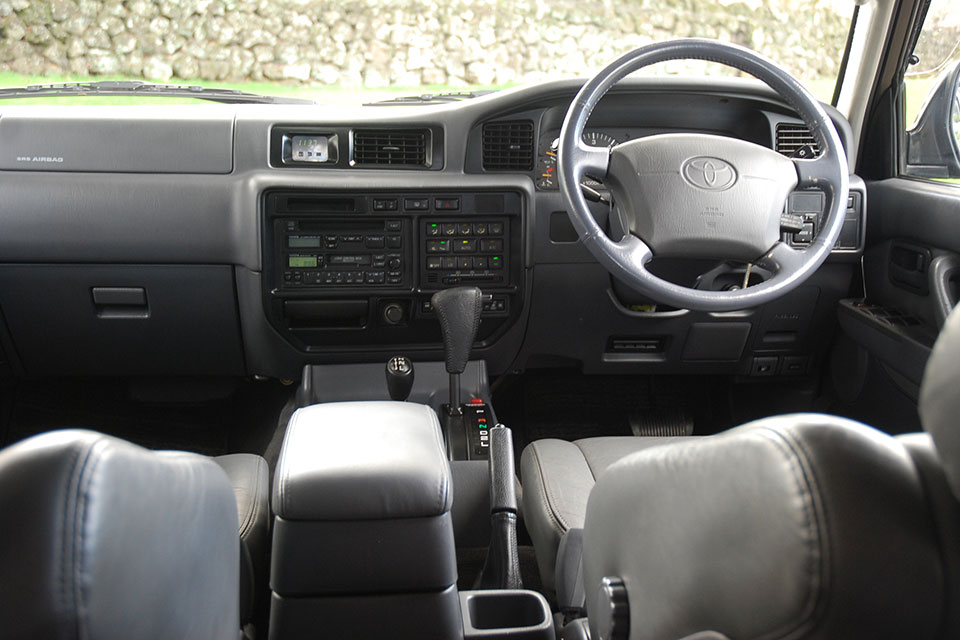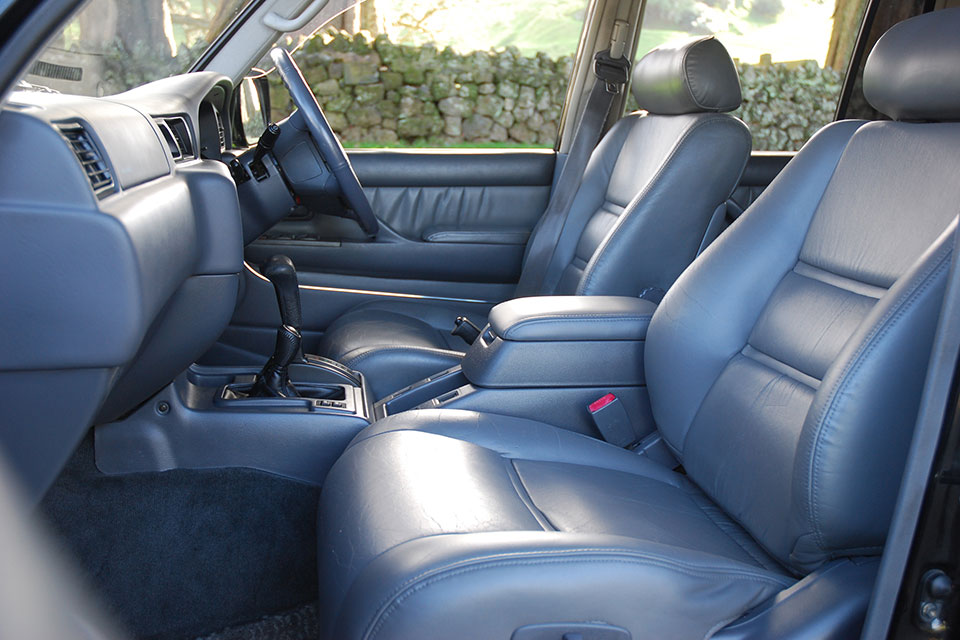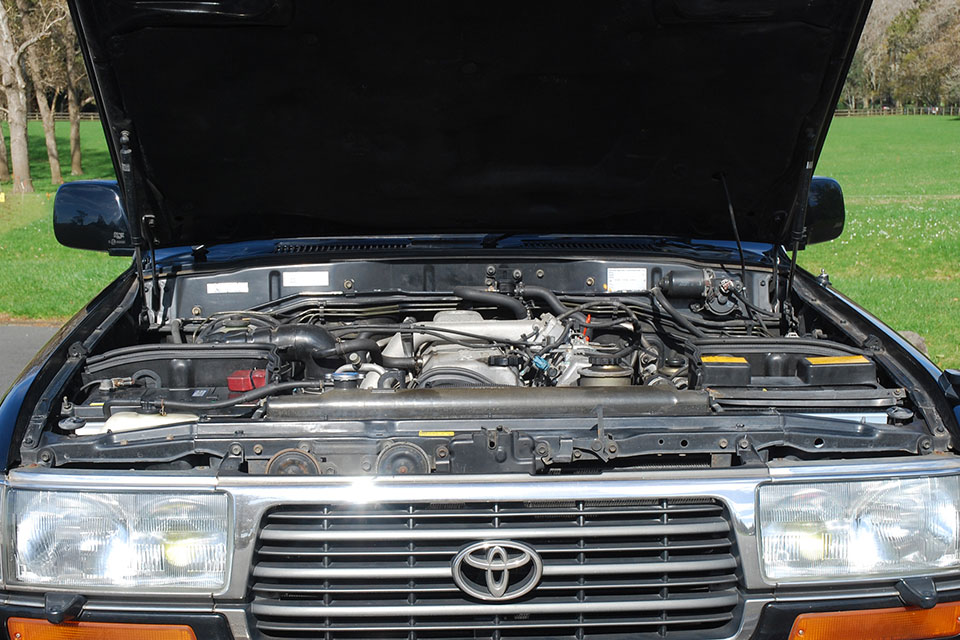Toyota Land Cruiser 1990-1997 used car review
The Toyota Land Cruiser is an imposing, rugged vehicle.

The Toyota Land Cruiser is an imposing, rugged vehicle. Top models offer luxury options, though the rear seat is small and the engine loud.
Originally developed for the Japanese military, the Toyota Land Cruiser has become legendary around the world as a durable, go-anywhere vehicle. It was launched in 1990 and the 80-series version reviewed here had new luxury, options and safety features. It was sold alongside a more work-focused 70-series model.
Inside and out
The Land Cruiser looks big, imposing and ready for anything. There’s a massive grille at the front which feeds air to the large engine, and wide headlights made up of two separate units. Toyota has worked to soften the vehicle’s edges though it is, ultimately, a big box.
The rear door on our VX Limited is split horizontally - the top half opens upwards and the lower half downwards to create a workbench or seat. Some versions feature vertical “barn” style doors.
Inside, the VX is an unusual mix of utility and luxury. The dash and door trims are made of a thick, durable plastic while the seats and steering wheel are covered in quality grey leather. The centre of the dash features controls for the CD and cassette tape stereo and climate control air-conditioning.
A second lever next to the transmission shifter controls the four-wheel drive system. There’s an electric sunroof and a panel showing a compass and barometer at the top of the windscreen.
The front seats are plump, soft and very comfortable. You sit high in the vehicle which itself sits high on the road, so you have a panoramic view. The rear seats are also soft and comfortable and there is room for three adults.
Legroom, however, is disappointing given the size of the car. The rear doors are also quite short which makes getting in and out a little tricky. A third row of seating for three is an option.
The boot is huge - we think it could fit six, if not more, large suitcases. Tumble the second row forward and large loads such as two to three mountain bikes can be carried. If you need to get large items into the rear it could be a struggle: you need to lift them high up to the tailgate and then forward from the drop-down section.
On the road
The Land Cruiser is available in a range of large six-cylinder engines. Early petrol versions got a 4-litre engine, with a 4.5-litre introduced later. A 4.2-litre non-turbocharged engine was fitted to a small number of cars and most New Zealand-new vehicles are powered by a turbocharged version of this.
Japanese import VX models get a higher-output 4.2-litre diesel, including our review car. The review vehicle’s engine puts out 125kW and 380Nm. That does not sound a lot for the size of the vehicle but it is delivered at low engine speed and is ideal for off-road driving or heavy towing. The Land Cruiser does not feel particularly fast; you will need to plan overtaking moves in advance.
The Land Cruiser feels a lot like a truck to drive. It’s heavy on the road, there is significant body roll and it does not like to change direction suddenly.
The steering is quite vague though nicely weighted. The brakes are excellent – they’re engineered to be large to cope with heavy work. Full time all-wheel drive means the grip is good though that does depend on whether the tyres are biased towards on-road or off-road driving. Engine and tyre noise is quite high and can become invasive when you accelerate or when the vehicle is under load.
The Land Cruiser is excellent off-road, particularly the VX model with its locking centre, front and rear differentials. That means power can be sent equally to all four wheels for very slippery surfaces, or situations where one or more wheels might be lifted off the ground. Many Land Cruisers on the market are fitted with off-road accessories such as winches, suspension lift kits and underbody protection.
The size, however, makes the vehicle daunting to park. Neither reversing sensors or a camera are offered as options. If you fit a camera yourself it will cost from $50 or a professional will do it from $200.
The Land Cruiser’s official tow rating is surprisingly low for its size. It can handle 750kg unbraked (a medium-sized garden trailer) and 2,500kg braked (a medium to large trailer boat).
Safety
RightCar lists the Land Cruiser as having a low two-star Used Car Safety Rating (1990-1997). Safety features are basic, with anti-lock brakes standard on VX and VX Limited models, and front airbags fitted from 1995.
The rear seat features a lap-belt in the centre position, which offers less protection than the shoulder-type. There are no ISOFIX child seat mounts. Two child seat anchor points are available on the rear floor.
Reliability
Land Cruisers are sturdy, durable and relatively simple mechanically. They are great workhorses and have often been operated accordingly. Most of the issues that surface by this age are down to how the vehicles were used. Even strong components can fail eventually. We recommend getting an expert to look closely at any 80-series.
The 4.2-litre engine in our review vehicle uses a cam belt which requires regular replacement. The power plant is considered durable although excessive exhaust smoke on high-mileage examples – more than 200,000km - is an indication that an expensive rebuild could be necessary.
Rare cases of cracking around the body mounts are caused by rough roads and heavy towing. Get under the vehicle and look for cracks in the body where it meets the chassis. While you are down there also look for rust on both the frame and the body. It is not common but it can occur on vehicles that have been used around salt water.
Manual transmissions with higher mileage can have problems with their synchros, which causes harsh shifting between second and third.
The issue can sometimes be fixed with a fluid change although a rebuild might ultimately be required – it will cost around $2,000. The automatic is good, although it does like to be serviced and it can overheat if it’s used for heavy towing. When you test drive the vehicle, make sure it is shifting quietly and relatively smoothly. It’s also important to check that the four-wheel drive and low-range transfer case are also operating properly.
The leather seats in the VX Limited have been known to harden and crack over the years. Re-upholstery can cost thousands and used replacements are tricky to find. The best way to fix the problem is to invest in a set of car seat covers.
Cost of ownership
Toyota recommends servicing the Land Cruiser every 12 months or 15,000km, whichever comes first. Services cost around $400 each. The cam belt requires replacement every 100,000km, and this will cost from $1,200.
RightCar does not list running costs for this generation Land Cruiser. The originally claimed fuel consumption is 11.2-litres per 100km, which is surprisingly low when you consider the size of the car. The 95-litre fuel tank will cost $137.75 to fill at $1.45 per litre of diesel and should let you travel 800km before the fuel light comes on.
A vehicle licence for the Land Cruiser costs $227.73 a year, with the car in the most expensive ACC levy group.
Trade Me Insurance estimates insurance for a Land Cruiser valued at $17,640 will cost $61.63* per month, the same as a Nissan Pathfinder of the same year. This is $10 more a month than for a Nissan Patrol.
Buyers' guide
The 80-series Land Cruiser is available on Trade Me priced from $6,000 to $54,000 for later and lower mileage vehicles. Petrol-powered Land Cruisers are worth as much as 50% less than diesel versions.
This model is available again as a freshly used import from Japan as it is older than 21 years. These cars are usually highly specified VX Limited models and have lived a gentler life than their New Zealand-new counterparts.
A small number of ute versions of the 80-series are available in both single and double cab form. These are custom built vehicles, and fetch high prices when they come up for sale. They were not created by Toyota.
Variants
- GX - Fitted with steel wheels, manual air-conditioning, electric windows, electric mirrors and centre diff lock.
- VX - Adds alloy wheels, front and rear diff locks, climate control air-conditioning, sunroof, front airbags (from 1995) and anti-lock brakes.
- VX Limited - Adds running boards, premium seats - with leather on New Zealand-new models - leather steering wheel and cruise control.
Timeline
- 1990 Launched globally
- 1992 Land Cruisers with anti-lock brakes get front and rear locking differentials
- 1993 New 4.5-litre six-cylinder petrol engine is added and the overall wheelbase is extended slightly
- 1995 Driver and passenger airbags are added
- 1998 Production for most markets, including New Zealand, ends
Details
1996 Toyota Land Cruiser 80-series VX Limited
$15,000 to $32,000 for models which have travelled 70,000 to 120,000km
4.2-litre six-cylinder turbocharged diesel, 125kW/380Nm (claimed)
Four-speed automatic, four-wheel drive
Two-star Used Car Safety Rating
15,000km or twelve months
Full size wheel
11.2-litres per 100km (claimed)
Diesel
4810mm
1875mm
1865mm
750kg (unbraked), 2500kg (braked)
12m
This review covers the Toyota Land Cruiser for model years 1990, 1991, 1992, 1993, 1994, 1995, 1996 and 1997.
Review vehicle supplied by Unique Japan.
*Our insurance estimates are based on a 35-year-old male with no accidents in the last two years, garaging the car in Mission Bay, Auckland. The car is not used for business and will cover 10,000km to 20,000km a year. We estimate with no option add-ons and $500 excess. Customise your estimate at Trade Me Insurance.
Image gallery
Also consider






